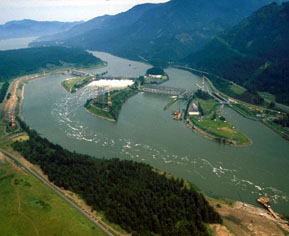 |
|
|
||||
| Oregon Water Science Center |
Total Dissolved Gas and Water Temperature in the Lower Columbia River, Oregon and Washington, 2006: Quality-Assurance Data and Comparison to Water-Quality Standards |
By Dwight Q. Tanner, Heather M. Bragg, and Matthew W. Johnston |
U.S. Geological Survey Data Series 235 |
Prepared in cooperation with the U.S. Army Corps of Engineers |
| ONLINE ONLY (download the report) |
|
When water is released through the spillways of dams, air is entrained, increasing the downstream concentration of dissolved gases. Excess dissolved-gas concentrations can have adverse effects on freshwater aquatic life. The U.S. Geological Survey (USGS), in cooperation with the U.S. Army Corps of Engineers, collected dissolved-gas concentration and water-temperature data at eight stations on the lower Columbia River in 2006. Significant findings from the data include:
|
 Bonneville Dam on the Columbia River |
|
USGS scientists calibrate a dissolved-gas monitor downstream from the Bonneville Dam spillway |
|
|
Download the report (PDF, 1.5 MB) (Adobe Reader® required; version 5 or higher preferred. If you do not have the Adobe PDF Reader, it is available for free download from Adobe Systems Incorporated.) Contents
Introduction |
|
|
Document Accessibility: Adobe Systems Incorporated has information about PDFs and the visually impaired. This information provides tools to help make PDF files accessible. These tools convert Adobe PDF documents into HTML or ASCII text, which then can be read by screen-reading programs that synthesize text as audible speech. In addition, a version of Adobe Reader that contains support for screen readers is available. The conversion tools and the accessible reader may be obtained free from Adobe through their conversion tools Web site. For information on ordering Oregon Water Science Center publications, click on this link. To learn more about USGS activities in Oregon, please visit our home page. | |